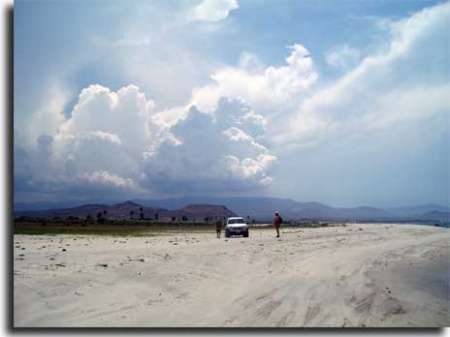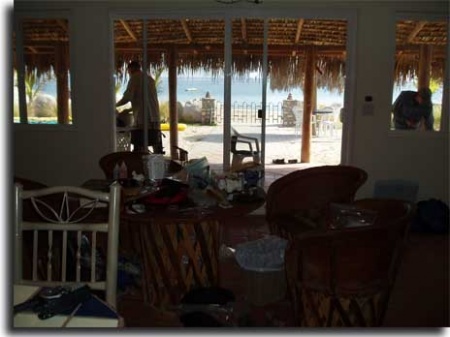 If previous trips south have been referred to as “Brandon’s 30 pound Rooster trip†or “Doug’s Big Rooster tripâ€, or “The Beach Caught Dorado tripâ€, this trip’s reference would simply be “Varietyâ€.
If previous trips south have been referred to as “Brandon’s 30 pound Rooster trip†or “Doug’s Big Rooster tripâ€, or “The Beach Caught Dorado tripâ€, this trip’s reference would simply be “Varietyâ€.

The reports had read that the bait (sardina) were in, unlike last year. They weren’t kidding! As we pulled up to the house, before even getting out of the jeep we could see clouds of bait scattered up and down the beach!
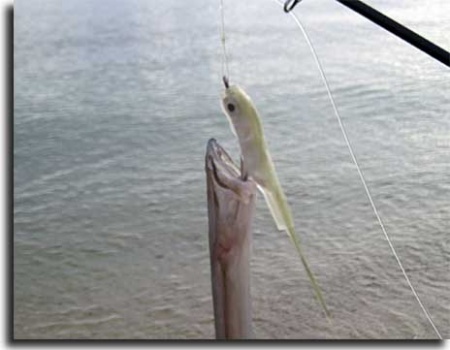
A floating gummy minnow made for some fun top-water action in the early mornings catching lady fish, needle fish, cornet fish, porgies, triggerfish, and just about everything else.
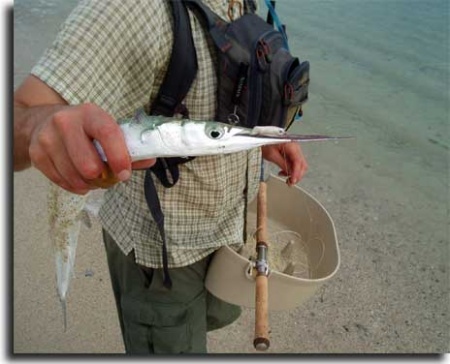
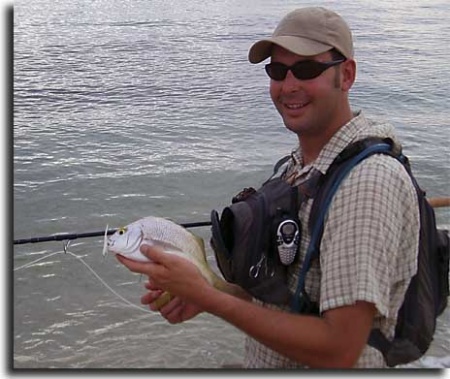
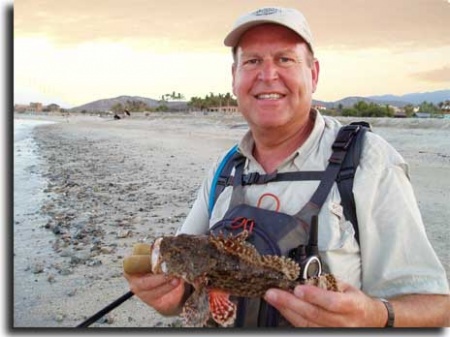
This was a new species for us. I asked my dad over the radio what it was he’d just landed. It took him a few minutes to respond, “umm… I have no idea�
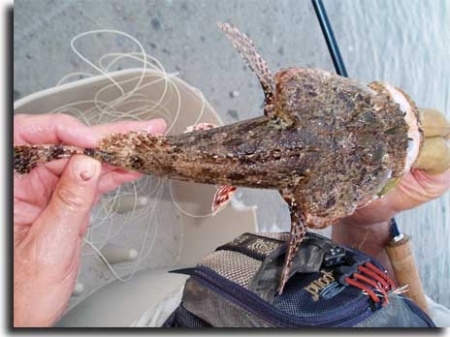
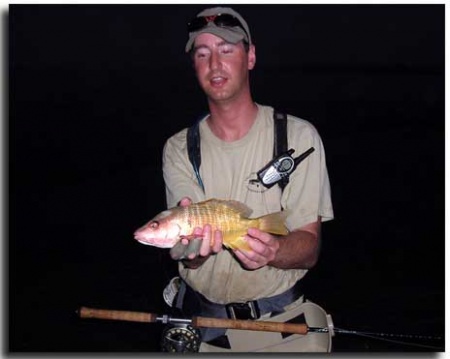
Once the sun has set, there’s no telling what you’ll catch, unless of course you are Brandon. In which case it’s pargo.
I was generous enough to let this spiny creature keep my targus hair minnow as a souvenir.
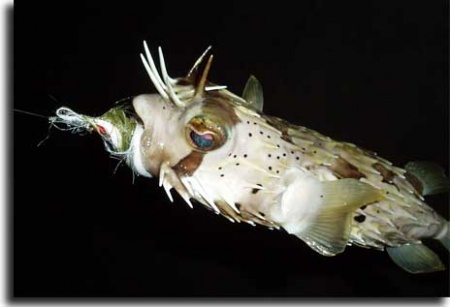
Blind casting big mullet patterns into the dark water and retrieving like a madman was really paying off with a good percentage of retrieves being chased down by roosters.
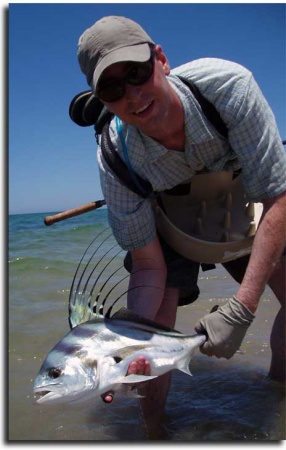
Most were small, but enough of the time bubba would surprise you, coming out of nowhere in hot pursuit of your fly, rarely ever grabbing, but exhilarating all the same.
This five pounder started tracking Brandon’s fly at the end of his cast. Keeping the fly accelerating while two hand stripping like crazy finally convinced him to eat, literally at Brandon’s feet. It was amazing to see how quickly that junior-sized fish cleared the 100 feet of running line from his stripping basket.
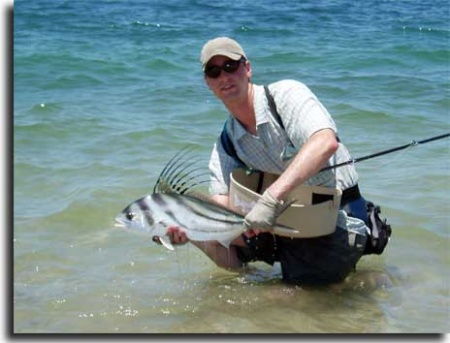
On previous trips we had developed a fondness for the pelican. If pelicans were around, there was bait. When you find bait, it’s only a matter of time before the big fish arrive.
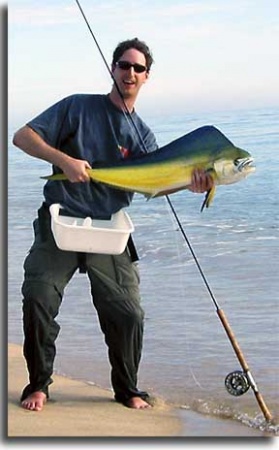 If pelicans are crashing the surface, it’s a direct indication that there’s something below driving the bait to the surface. If a group of pelicans suddenly take flight, all headed in the same direction, take note. Brandon and I shared a double dorado hook-up last year that was a direct result from paying close attention to the pelicans.
If pelicans are crashing the surface, it’s a direct indication that there’s something below driving the bait to the surface. If a group of pelicans suddenly take flight, all headed in the same direction, take note. Brandon and I shared a double dorado hook-up last year that was a direct result from paying close attention to the pelicans.
This year we learned what a nuisance they could be (once they’d shown us the bait of course). No matter how careful you were, it was only a matter of time before one either flew into your airborne fly line or dove for your fly. When the roosters would charge the bait to the surface, it was you against the pelicans. Nine times out of ten, they won.
John Steinbeck wrote about the black cormorants off of Cape San Lucas in his 1941 book, The Log From The Sea Of Cortez.
All the time we were indulging in courtliness there had been light gunfire on the cliffs, where several men were shooting at black cormorants; and it developed that everyone in Cape San Lucas hates cormorants. They are the flies in a perfect ecological ointment. The cannery cans tuna; the entrails and cuttings of the tuna are thrown into the water from the end of the pier. This refuse brings in schools of small fish which are netted and used for bait to catch tuna. This closed and tight circle is interfered with by cormorants, who try to get at the bait-fish. They dive and catch fish, but also they drive the schools away from the pier out of easy reach of the baitmen. Thus they are considered interlopers, radicals, subversive forces against the perfect and God-set balance on Cape San Lucas. And they are rightly slaughtered , as all radicals should be. As one of our number remarked, “Why, pretty soon they’ll want to vote”.
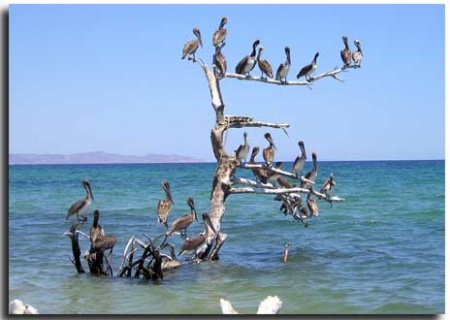
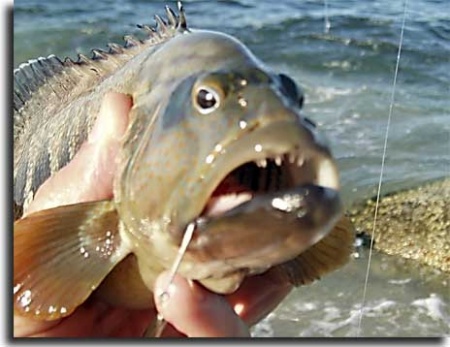
My dad and I experienced a number of doubles, mostly after locating a school of lady fish. This one was interesting because they were two different species!
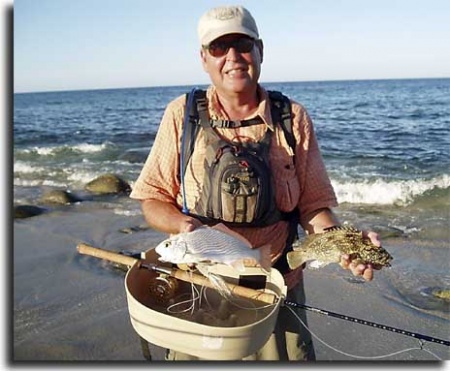
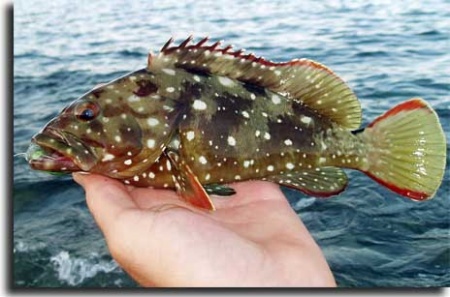
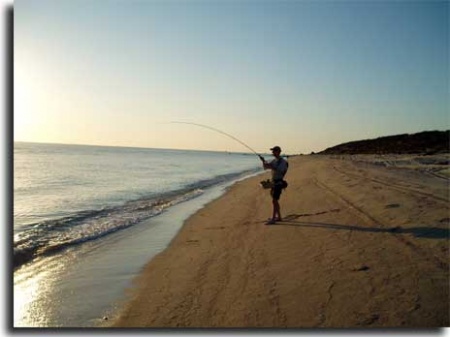
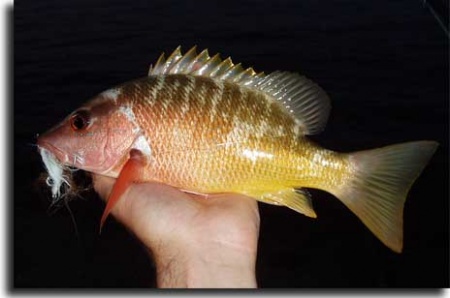
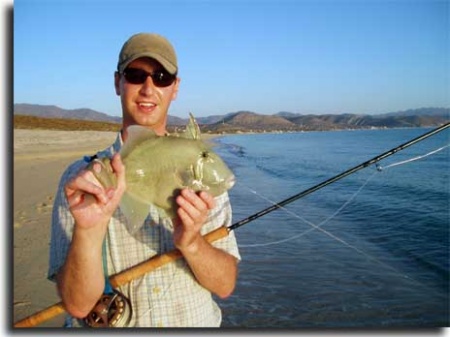
After the picture, Brandon was brought to his knees learning a valuable lesson when dealing with crustacean-crushing trigger fish, “keep your fingers out of their mouthsâ€.
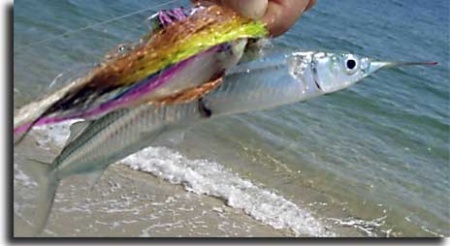
The large amount of bait caused more problems than just keeping the pelicans on their toes. While having my fly mowed down in high speed pursuit by bubba, just as he was closing-in, he turned and I was hooked up! Well, it turns out my “fleeing mullet†had apparently lost its appeal when it suddenly snagged an unsuspecting ballyhoo. And I would have thought a fish as intelligent as a rooster fish would have recognized a 2 for 1 deal when he saw it.
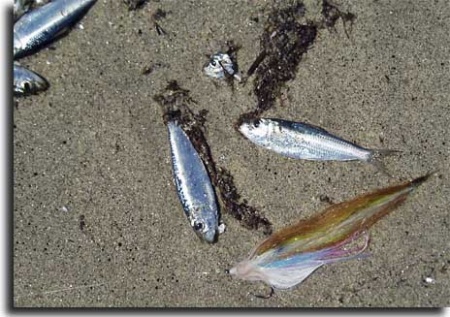
Dead sardina scattered on the beach was a clear indication that bigger fish had been working the beach.
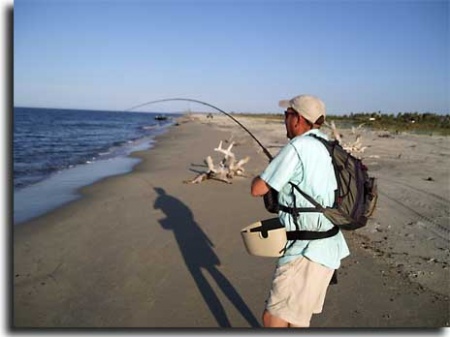
Dad got into a couple of nice little jacks one evening. It always amazes me at the bend these little guys can put into a big rod.
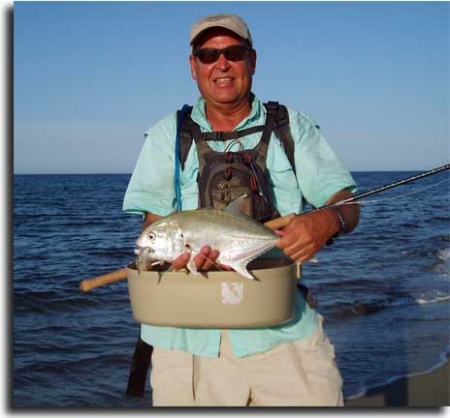
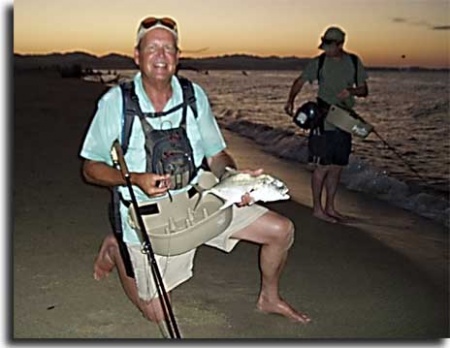
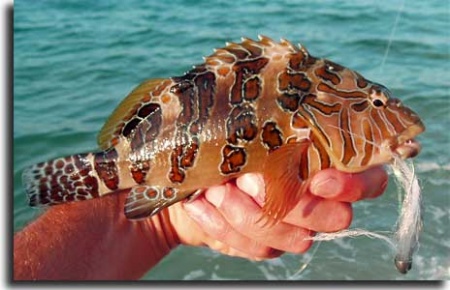
The variety just kept coming. I don’t think an evening went by that we didn’t find our selves flipping through the “Fish of the Sea of Cortez†identification book.
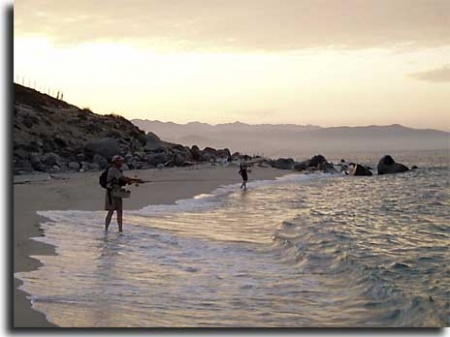
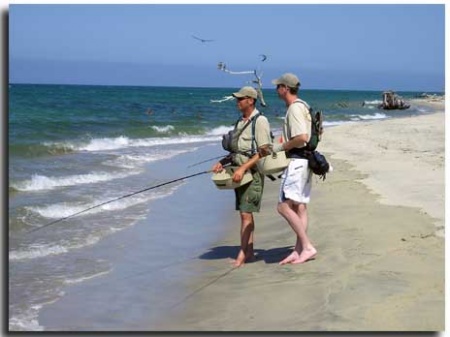
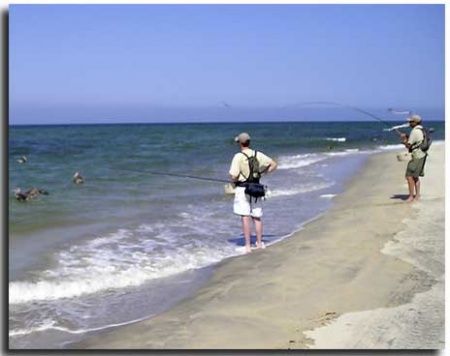
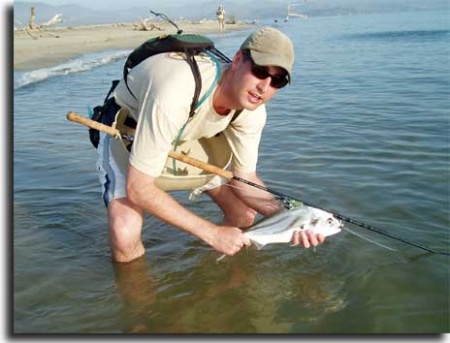
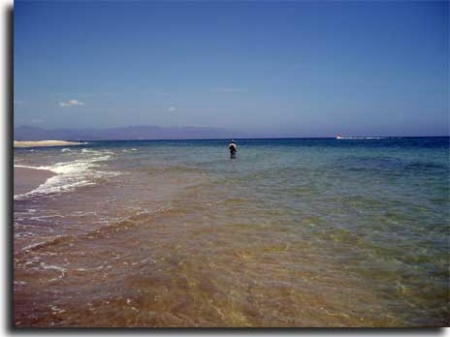
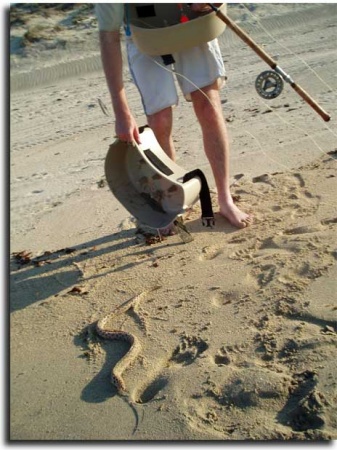
Our first eel, we weren’t sure how to handle it. The stripping buckets helped, but the thing was like a snake, a really nasty snake, with its mouth wide open trying to bite everything in site. We never really did get a good picture, but my dad had his video camera out so I’m sure there will be some pretty humorous video coming out soon of the two idiots dancing around trying to get the hook out without getting bit.
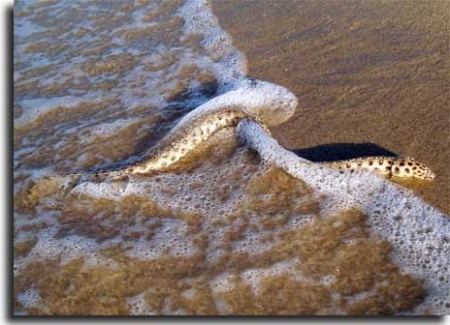
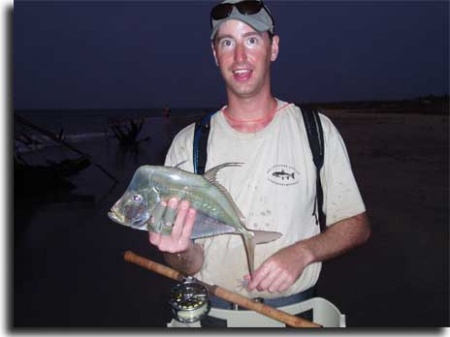
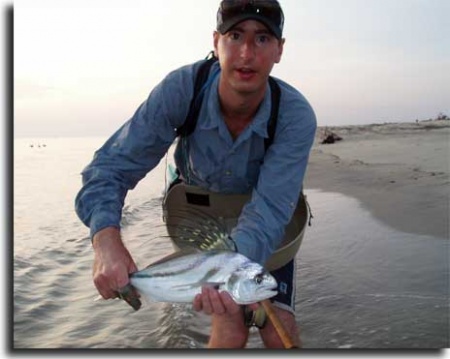
Brandon was on fire this morning with the baby roosters. You could see these little guys buzzing in with their little rooster fins out of the water terrorizing the small bait in the early morning. He managed to land four just blind casting and stripping erratically.
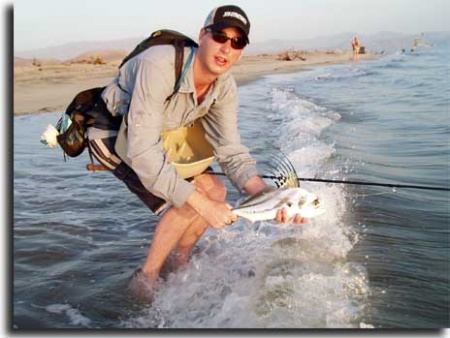
There is a crab found on the beaches down there with a reputation for avoiding capture. It goes by the name of Sally Lightfoot. John Steinbeck describes them best in his Sea of Cortez book.
Many people have spoken at length of the Sally Lightfoots. In fact, everyone who has seen them has been delighted with them. The very name they are called by reflects the delight of the name. These little crabs, with brilliant cloisonné carapaces, walk on their tiptoes, They have remarkable eyes and an extremely fast reaction time. In spite of the fact that they swarm on the rocks at the Cape [San Lucas], and to a less degree inside the Gulf [of California], they are exceedingly hard to catch. They seem to be able to run in any of four directions; but more than this, perhaps because of their rapid reaction time, they appear to read the mind of their hunter. They escape the long-handled net, anticipating from what direction it is coming. If you walk slowly, they move slowly ahead of you in droves. If you hurry, they hurry. When you plunge at them, they seem to disappear in a puff of blue smoke—at any rate, they disappear. It is impossible to creep up on them. They are very beautiful, with clear brilliant colors, red and blues and warm browns.
…
Man reacts peculiarly but consistently in his relationship with Sally Lightfoot. His tendency eventually is to scream curses, to hurl himself at them, and to come up foaming with rage and bruised all over his chest. Thus, Tiny, leaping forward, slipped and fell and hurt his arm. He never forgot nor forgave his enemy. From then on he attacked Lightfoots by every foul means he could contrive and a training in Monterey street fighting has equipped him well for this kind of battle). He hurled rocks at them; he smashed at them with boards; and he even considered poisoning them. Eventually we did catch a few Sallys, but we think they were the halt and the blind, the simpletons of their species. With reasonably well-balanced and non-neurotic Lightfoots we stood no chance.
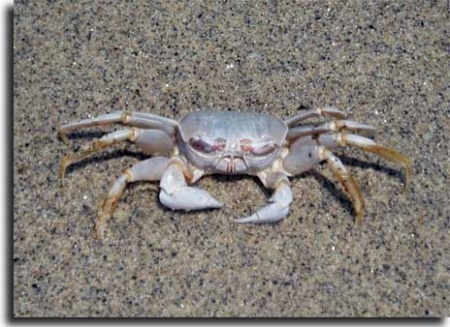
Our last day of walking the beaches for cruising roosters started out flat calm with no wind. As I walked, peering into the glassy, crystal clear water, I had a few opportunities to cast to some small jacks in water that was four feet deep. Each time the fish scattered as the shadow of the fly line crept across the bottom on its descent. A slight breeze picked up and before long here came my first legitimate shot, big bubba, probably pushing 50 pounds was headed my way, parallel to the beach, 50 feet out. My 12 inch mullet imitation crossed his path, 3 feet in front of him. He didn’t even blink. I had another half dozen shots as the wind steadily increased over the next hour.
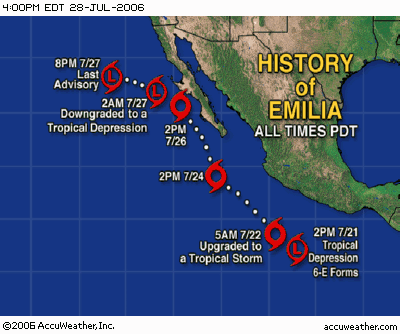 The clouds were coming in and the wind was really picking up. On our walk back to the jeep, Brandon got a good shot at a 30+ pound rooster, I’d have sworn was going to eat. The visibility was really getting bad and these two big roosters caught us off guard sneaking up behind us less than 15 feet off the beach. Brandon’s lightning-quick reflexes slap his 12 inch fly down two feet in front of the cruising oil drums and the lead fish explodes, fins up, gills flared, and charging. I still can’t believe he didn’t grab. It was our last day, and that was the end of the roosters for us. Tropical storm Emilia was pushing in cloud cover and wind that appeared to be staying, destroying the visibility 3 hours early.
The clouds were coming in and the wind was really picking up. On our walk back to the jeep, Brandon got a good shot at a 30+ pound rooster, I’d have sworn was going to eat. The visibility was really getting bad and these two big roosters caught us off guard sneaking up behind us less than 15 feet off the beach. Brandon’s lightning-quick reflexes slap his 12 inch fly down two feet in front of the cruising oil drums and the lead fish explodes, fins up, gills flared, and charging. I still can’t believe he didn’t grab. It was our last day, and that was the end of the roosters for us. Tropical storm Emilia was pushing in cloud cover and wind that appeared to be staying, destroying the visibility 3 hours early.
